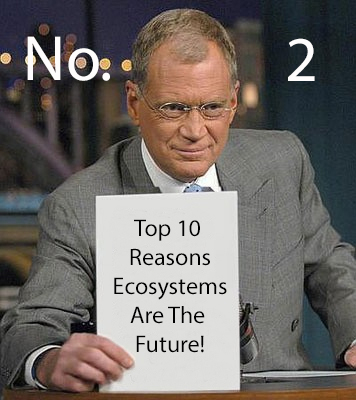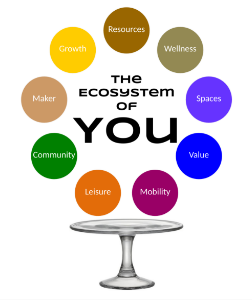 I’m counting down the top ten reasons that ecosystems are to become the dominant structure of the future. In the previous post of this series, I presented the concept of abundance, noting that exponential technologies are enabling us to meet the world’s subsistence needs while ecosystems are emerging as alternatives to our current industries.
I’m counting down the top ten reasons that ecosystems are to become the dominant structure of the future. In the previous post of this series, I presented the concept of abundance, noting that exponential technologies are enabling us to meet the world’s subsistence needs while ecosystems are emerging as alternatives to our current industries.
In this post, I will focus more specifically on how ecosystems will evolve as our values progress.
Platform Capitalism is Leading the Transition to Ecosystems
Throughout this countdown, I’ve correlated the progression of human values to that of society and business and highlighted how ecosystems are underpinning that progression. So far, I’ve focused extensively on the emerging community; and interdependence value systems – but what of capitalism and the prosperity value system? With its centuries long dominance, it’s hard to imagine it being superseded. Yet, the very drive to compete that embodies the spirit of capitalism and the prosperity system actually holds the key to the transition to ecosystems and the emerging value systems. How could the community and interdependence systems be enabled by a focus on capitalism? In fact, this is already happening. Writing on the Sharing Economy, author Tevor Scholz refers to platform capitalism as a business model that creates enormous profits for entrepreneurs by utilizing software platforms to efficiently connect service providers to customers.
“Sascha Lobo and Martin Kenney recently introduced the term platform capitalism, which I’d define in reference to subcontracting and rental economies with big payouts going to small groups of people. [] it is hard to deny that baby boomers are losing sectors of the economy like transportation, food, and various other services, to millennials who fiercely rush to control demand, supply, and profit by adding a thick icing of business onto apps-based user interactions.”
This phenomenon whereby longstanding industries are disrupted by platform-enabled ecosystems that deliver convenient, on-demand services is gaining serious momentum and creating powerful ecosystems.
Creating Hyper-productivity Through Platform Capitalism
Let’s examine Uber, perhaps the most recognized platform-enabled ecosystem. Uber’s ecosystem replaces human dispatchers with artificial intelligence and algorithms in a centralized mobile application that conveniently connects drivers and riders. Uber has squeezed the inefficiency out of the old system by disinter-mediating human dispatchers, creating a hyper-productive experience. Next, Uber will deploy autonomous electric vehicles run on renewable energy and the experience will eliminate labor and fuel costs, becoming even more productive. Now, imagine if this ecosystem were to be broadened further. Applying Uber’s mobility algorithms to an IoT network of airlines, railroads, logistics companies and automotive manufacturers underpinned by blockchain-enabled smart contracts that autonomously distribute value among participants, this could create a hyper-productive mobility ecosystem that moves people and things from point A to point B with unparalleled efficiency.

As this hyper-productivity process continues, the lines between industries will dissolve and the cost of these combined services will drop drastically as they become “uber”convenient utilities that address our fundamental needs seamlessly. In fact, the more that non value-added industry participants are removed from a process via ecosystem principles, the more productive the experience becomes for the remaining participants.
Hyper-productive platforms and ecosystems are not limited to mobility. I have identified nine ecosystems emerging to create hyper-productive experiences across every aspect of our lives in my Ecosystem Of You model. I’ll focus on these ecosystems and the hyper-productive life experiences they are likely to create in future posts.
The Dichotomy of Ecosystems
Uber’s model is a great example of the use of disruptive technology to perpetuate profit-centric prosperity values, rather than pursue emergent community values. This underscores an emerging dichotomy whereby hyper-productivity creates convenient cost-effective experiences while simultaneously exacerbating inequality. This is already happening in the Uber model as some people, motivated by community values, are wondering why Uber’s owners are not sharing their handsome profits more equitably throughout their ecosystem. This contradiction exemplifies what economist Paul Mason refers to as the struggle between the network (community values) and the hierarchy (prosperity values):
“The main contradiction today is between the possibility of free, abundant goods and information; and a system of monopolies, banks and governments trying to keep things private, scarce and commercial. Everything comes down to the struggle between the network and the hierarchy: between old forms of society moulded around capitalism and new forms of society that prefigure what comes next.”
The technology upon which Uber was created can be replicated in an open, equitable business model. Tevor Scholz describes this as platform cooperativism:
“Take, for example, Uber’s app, with all its geolocation and ride ordering capabilities. Why do its owners and investors have to be the main benefactors of such platform-based labor brokerage? Developers, in collaboration with local, worker-owner cooperatives could design such a self-contained program for mobile phones.”
Indeed, La Zoos has already created a platform cooperative version of Uber using blockchain technology. Yet, while it is a socially conscious and equitable mobility solution, it has struggled for adoption in the face of the capitalistic forces backing Uber and its $62 billion valuation. Likewise, Vertical Farms, Zero Net Water and Waste Buildings, Zero Net Energy Homes, Peer to Peer Lending, and Peer to Peer Insurance are socially conscious innovations that demonstrate ecosystem principles. Yet, their acceptance is largely dependent upon their ability to compel people in a capitalistic free market. They must compete on the basis of price, quality and convenience to gain widespread adoption. There are, no doubt, those who would pay a short-term premium for these solutions based on their societal value alone, but the vast majority of people will not or cannot. Thus, the model that provides the most compelling experience and price is likely to achieve the widest adoption. And the capitalistic prosperity system, which excels at continuously improving efficiency and driving down prices is currently better suited to drive adoption of the ecosystem model.
So where does that leave the community and interdependence value systems?
Hyper-productivity and the Evolution of Ecosystems
In spiral dynamics, human priorities (value systems) guide one’s evolution based on the conditions they are living in. The transition from one value system to the next is triggered by an improvement in life conditions. Therefore, the transition from the prosperity system to the community and interdependence systems can only occur when life conditions become prosperous. For community values to emerge to prominence, the prosperity system and its relentless drive to increase efficiency must first make our lives so productive and convenient that we seek out higher priorities. How might this occur?
Capitalism and ecosystems are going to create hyper-productive experiences that make all aspects of life prosperous. In a world where robots and algorithms more intelligent than humans interact via an IoT cloud of conceivably every object on the planet (including humans) and exchange value inside super-efficient blockchain databases, three things are likely to happen.
First, downward pressure on prices will accelerate a zero marginal cost society as described by economist Jeremy Rifkin where “ever more efficient technologies, accelerate productivity to the point where the marginal cost of production approaches zero, making goods and services “priceless” and potentially free, putting an end to profit and rendering the market exchange economy obsolete.”
Second, as prices approach zero, goods and services will transition to sharing ecosystems powered by decentralized autonomous organizations run on blockchain technology. Rifkin refers to these sharing ecosystems as the collaborative commons. LaZoos, the Uber clone, is an example of a sharing ecosystem before its time. As prices plummet and the profit motive for Uber erodes, a sharing ecosystem like LaZoos is likely to re-emerge and transform mobility into a shared utility on the commons.
Last, as more and more “life experience utilities” are available at near zero cost on the commons, our priorities will shift from individual needs of subsistence to addressing such societal issues as inequality, climate change, preservation of our resources and peace.
The combined effect of these will give rise to the community and interdependence systems. Using the ecosystem infrastructure built on the back of capitalism and hyper-productivity, the socially conscious solutions emerging out of the community and interdependence systems will come to prominence.
None of this is possible without capitalism, the prosperity system and hyper-productivity. Once all aspects of our lives are hyper-productive, the prosperity system will become insufficient to continue providing more meaningful life experiences. In essence, it will have served its purpose and the community and interdependence systems will emerge to enable us to evolve. That makes “Hyper-productivity” the number 2 reason that ecosystems are the future.
Next Up: Number 1 – Our Survival [Part 1]
Previous:
Number 3 – Abundance
Number 4 – Millennials
Number 5 – Purpose
Number 6 – Intrinsic Motivation
Number 7 – Freelancing & Coworking
Number 8 – The Collaborative Economy
Number 9 – Industry Platforms
Number 10 – Community Values

Outstanding post
Thank you, Frank 🙂
Your most penetratingly insightful post to date, David! And very timely as well.
Greg, thanks. You are too kind. 🙂